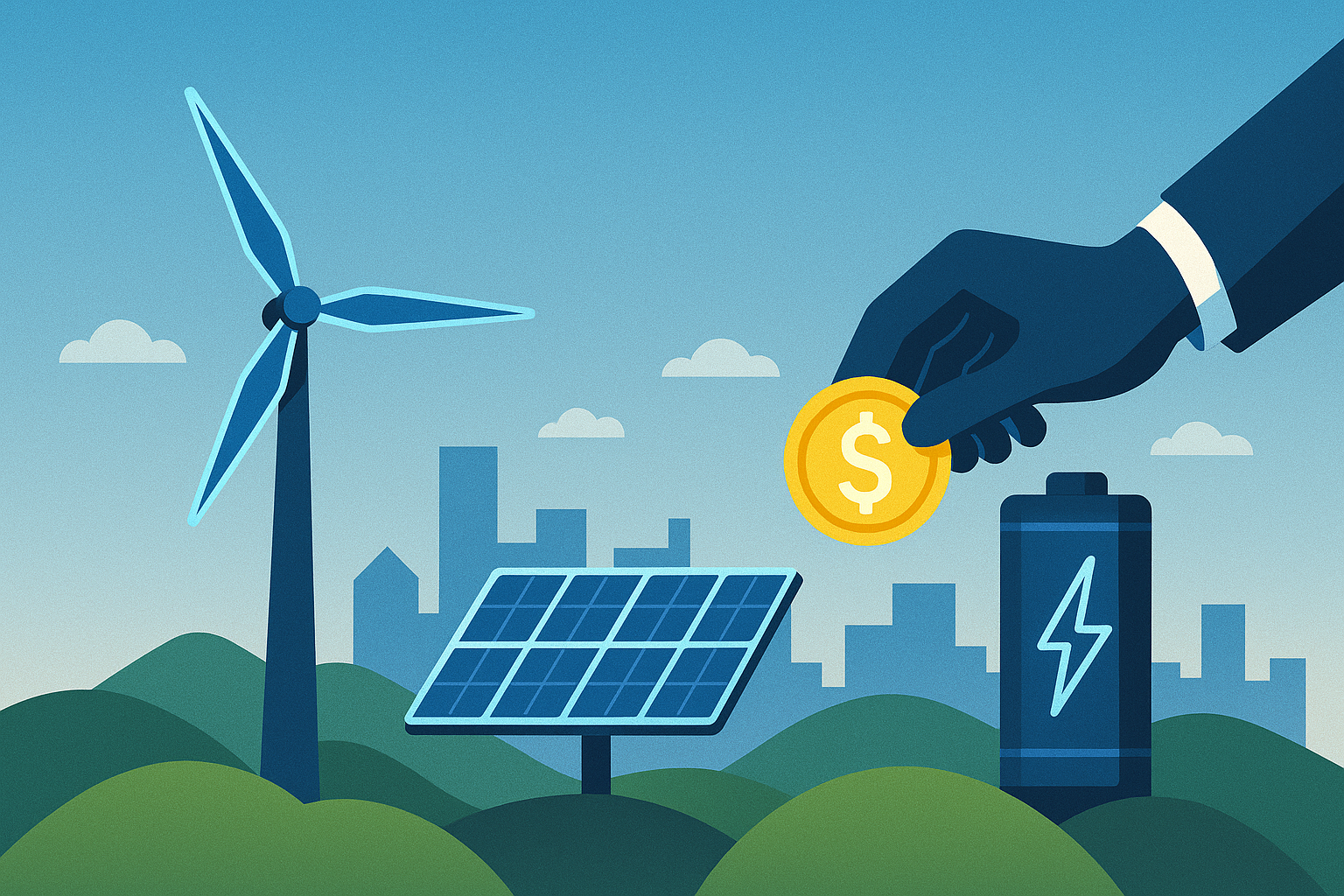Where Smart Capital Powers Tomorrow
Energy Transition Investment Outlook
By GrowEasy | Dubai, UAE | June 27, 2025
Executive Summary
The global shift toward decarbonization is transforming the natural resources sector, creating a new wave of investment opportunities across the Middle East, Africa, and post-Soviet states. As private equity (PE) deal values surged 14% to reach $2 trillion in 2024, capital is increasingly flowing into renewable power, green fuels, and sustainable infrastructure.
However, unlocking returns in this rapidly evolving environment requires navigating a complex mix of regulatory frameworks, technological change, and geopolitical uncertainty. This paper outlines five pivotal energy transition trends reshaping investment strategies across resource-rich regions in 2025 and beyond.
Green Hydrogen: A New Energy Frontier
Green hydrogen has emerged as a flagship pillar of energy transition strategies, particularly in resource-endowed, low-cost energy regions.
Regional Highlights
Middle East: The UAE and Saudi Arabia are leading with large-scale hydrogen projects, including NEOM’s $8.4 billion investment in hydrogen infrastructure. Oman’s Hydrom aims to deliver 4 GW of green hydrogen capacity.
Africa: Namibia’s $10 billion green hydrogen program is gaining traction with institutional investors and multilateral support.
Post-Soviet States: Uzbekistan is piloting hydrogen development as part of its energy diversification strategy, particularly for export resilience.
Investment Implications
Key opportunities lie in upstream hydrogen production (e.g., electrolysis), midstream infrastructure (e.g., pipeline logistics), and adjacent services such as storage and certification.
Strategic value may be enhanced through integration with carbon capture and renewable power sources.
Due diligence should assess technology scalability, water intensity, and policy reliability, particularly where subsidies or public-private partnerships are involved.
Renewable Power Acceleration
The acceleration of solar, wind, and energy storage deployment is creating new demand for capital, infrastructure, and technical services.
Regional Highlights
Africa: South Africa, Kenya, and Egypt are deploying over 3.85 GW of solar and wind, with growing support from regional development finance institutions (DFIs).
Middle East: Saudi Arabia targets 50% renewable energy generation by 2030, underpinned by mega-projects and integrated industrial zones.
Post-Soviet States: Uzbekistan report strong growth in renewable FDI, responding to EU demand for clean energy sourcing.
Investment Implications
Opportunities exist in renewable project developers, energy storage technologies, and smart grid infrastructure.
Integration with AI-powered data centers is emerging as a growth driver in sun-rich regions.
Policy incentives, including feed-in tariffs and investment tax credits, should be carefully reviewed in each jurisdiction.
Sustainable Chemicals and Green Industry
The chemicals and downstream industrial sectors are rapidly transitioning toward lower-carbon processes and bio-based inputs.
Regional Highlights
Middle East: Oman and the UAE are investing in green ammonia, bio-plastics, and hydrogen-based chemicals.
Africa: Nigeria and Kenya are scaling bio-fertilizer and agrochemical production aligned with food security and ESG goals.
Post-Soviet States: Belarus and Kazakhstan are exploring green feedstock diversification despite limitations on foreign investment.
Investment Implications
Investment targets include green chemical producers, advanced materials firms, and service providers integrating AI and resource-efficiency solutions.
Circular economy models—such as recycling of industrial byproducts or wastewater reuse—are becoming embedded in project design.
Trade and feedstock volatility remain key diligence issues, particularly in regions exposed to export controls or fragile import corridors.
Critical Minerals Mining
Mineral extraction remains a backbone of the energy transition, supplying lithium, cobalt, nickel, and rare earth elements for battery technologies and renewable infrastructure.
Regional Highlights
Africa: The Democratic Republic of Congo (DRC) accounts for 70% of global cobalt supply, with Zimbabwe and Namibia emerging as lithium exporters.
Middle East: Saudi Arabia is expanding mining under its $2.5 trillion minerals strategy, focused on copper, phosphate, and rare earths.
Post-Soviet States: Kazakhstan and Uzbekistan are developing low-carbon uranium and rare earth value chains to support nuclear and strategic industries.
Investment Implications
Opportunities span mining companies, mineral processing facilities, and logistics services for mineral transport and traceability.
Electrified operations and renewable-powered mining sites are increasingly viewed as competitive advantages.
Investors should assess geopolitical risk, licensing frameworks, and community engagement capacity as part of pre-deal assessments.
Smart, Green Supply Chains
Modernized supply chains are foundational to the success of the energy transition—enabling decarbonized production, logistics efficiency, and ESG compliance.
Regional Highlights
Middle East: Jebel Ali Port (UAE) and NEOM are incorporating green shipping corridors, blockchain-enabled trade, and hydrogen-ready logistics.
Africa: Nigeria’s Lekki Port is positioning as a regional green logistics hub, with AI-driven fleet optimization.
Post-Soviet States: Kazakhstan’s Belt and Road corridor investments are digitizing rail and border logistics to accelerate regional integration.
Investment Implications
Strategic opportunities lie in digital logistics platforms, clean fuel shipping solutions, and infrastructure firms supporting sustainable trade.
Integration with national sustainability strategies or global decarbonization standards (e.g., CBAM, IMO 2023) enhances value.
Sanctions exposure, regulatory fragmentation, and digital infrastructure readiness are critical due diligence areas.
Conclusion: The Energy Transition Investment Outlook
The energy transition in 2025 represents a high-growth, multi-decade opportunity for private capital. The convergence of climate policy, technological innovation, and industrial reinvention is reshaping traditional natural resource sectors across the Middle East, Africa, and post-Soviet states.
Key themes for investors include:
Scalability and Policy Certainty: Projects must align with national transition goals and benefit from long-term regulatory stability.
Operational Efficiency: Resource use, emissions intensity, and process optimization are key to profitability in new-energy sectors.
ESG and Stakeholder Alignment: Social license to operate and supply chain traceability are no longer optional; they’re foundational.
Timing and Exit Planning: Hydrogen, renewables, and green industry investments may offer peak exits between 2027–2030, but must account for subsidy cycles and geopolitical shifts.
By adopting a structured, risk-adjusted approach to energy transition assets, investors can align returns with sustainability mandates—while positioning portfolios for a future defined by resilience, innovation, and net-zero imperatives.
Explore Deeper
GrowEasy brings clarity, capability, and control to every stage of your investment journey
Connect with the Experts, Unlock Investment Success
Visit www.groweasy.ae or email us at info@groweasy.ae to understand more

